In the late seventies, personal computers were starting to emerge and generate interest among some people. I was mildly interested, but I had no idea what I would do with one. Suggested uses were things like: storing recipes, an electronic address book, or maybe play computer games like Star Trek. Mostly it seemed to be about writing programs in BASIC to, say, store recipes. Anyway, none of this really got me excited enough about computers to actually buy one.
All that changed when I came across a copy of a book by Ted Nelson called Computer Lib / Dream Machines. He wrote the first edition in 1974. The copy I bought was the 1980 edition. In it, Nelson presented a vision of computers as tools to enhance and expand human intelligence and creativity. One of the big ideas he talks about in the book is hypertext, a term he coined. Hypertext is, of course, one of the foundations of the Web, as in HTML, or Hypertext Markup Language. When you click on a link, that’s a kind of hypertext.
But, to Nelson, hypertext was much more than simple links to other documents. He envisioned a new kind of non-linear, dynamic form of literature, with variable levels of detail and hierarchy, tailored to the variable needs of authors and readers, all made possible by computers, which could do things that would be impossible on the printed page. After reading Computer Lib, I had to have a computer. I wanted to be part of this future.
Of course, it didn’t happen right away, this vision of Ted Nelson. When the Mac came out, everyone (including me) was astounded by its point-and-click graphical user interface. However, as I recall reading in one of the computer magazines of the day, Nelson was unimpressed. While he agreed that it was a good start, he criticized the Mac’s WYSIWYG presentation of text and graphics as being too limited, too static and bound to the ink and paper media of the past. The desktop publishing revolution, as amazing as it was for the print publishing world, fell far short of what was possible with this new digital medium.
In a few years, we got the World Wide Web. But, as Gerry Lieonidas tells in his talk (below), we are still in many ways stuck in print-oriented concepts, just as Ted Nelson was complaining back in 1984. When I saw Gerry’s talk earlier this evening, it immediately made me think of Ted Nelson and these ideas that got me excited about computers in the first place.
Gerry, I think you’re onto something.
Above: Gerry Leonidas on The Newest New Typography from Clearleft on Vimeo.
Arial is everywhere. If you don’t know what it is, you don’t use a modern personal computer. Arial is a font that is familiar to anyone who uses Microsoft products, whether on a PC or a Mac. It has spread like a virus through the typographic landscape and illustrates the pervasiveness of Microsoft’s influence in the world.
Arial’s ubiquity is not due to its beauty. It’s actually rather homely. Not that homeliness is necessarily a bad thing for a typeface. With typefaces, character and history are just as important. Arial, however, has a rather dubious history and not much character. In fact, Arial is little more than a shameless impostor.
Throughout the latter half of the twentieth century, one of the most popular typefaces in the western world was Helvetica. It was developed by the Haas Foundry of Switzerland in the 1950s. Later, Haas merged with Linotype and Helvetica was heavily promoted. More weights were added and it really began to catch on.
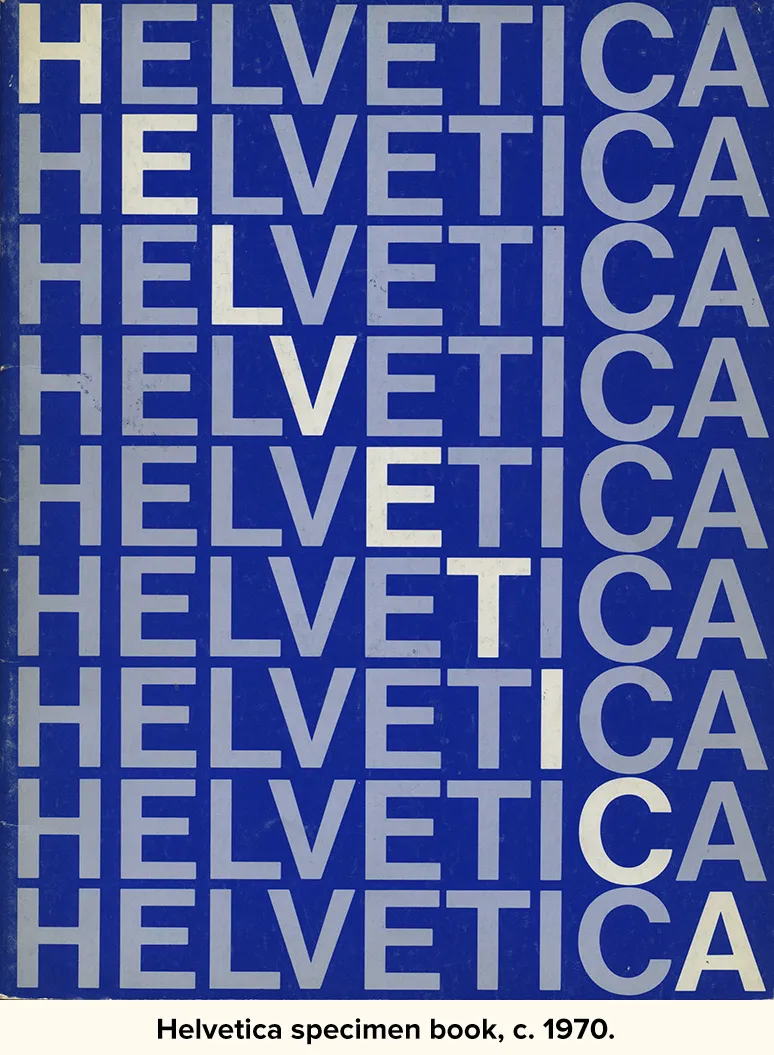
An icon of the Swiss school of typography, Helvetica swept through the design world in the ’60s and became synonymous with modern, progressive, cosmopolitan attitudes. With its friendly, cheerful appearance and clean lines, it was universally embraced for a time by both the corporate and design worlds as a nearly perfect typeface to be used for anything and everything. “When in doubt, use Helvetica” was a common rule.
As it spread into the mainstream in the ’70s, many designers tired of it and moved on to other typographic fashions, but by then it had become a staple of everyday design and printing. So in the early ’80s when Adobe developed the PostScript page description language, it was no surprise that they chose Helvetica as one of the basic four fonts to be included with every PostScript interpreter they licensed (along with Times, Courier, and Symbol). Adobe licensed its fonts from the original foundries, demonstrating their respect and appreciation for the integrity of type, type foundries and designers. They perhaps realized that if they had used knock-offs of popular typefaces, the professional graphic arts industry—a key market—would not accept them.
By the late eighties, the desktop publishing phenomenon was in full swing. Led by the Macintosh and programs like PageMaker, and made possible by Adobe’s PostScript page description language, anyone could do near professional-quality typesetting on relatively inexpensive personal computers.
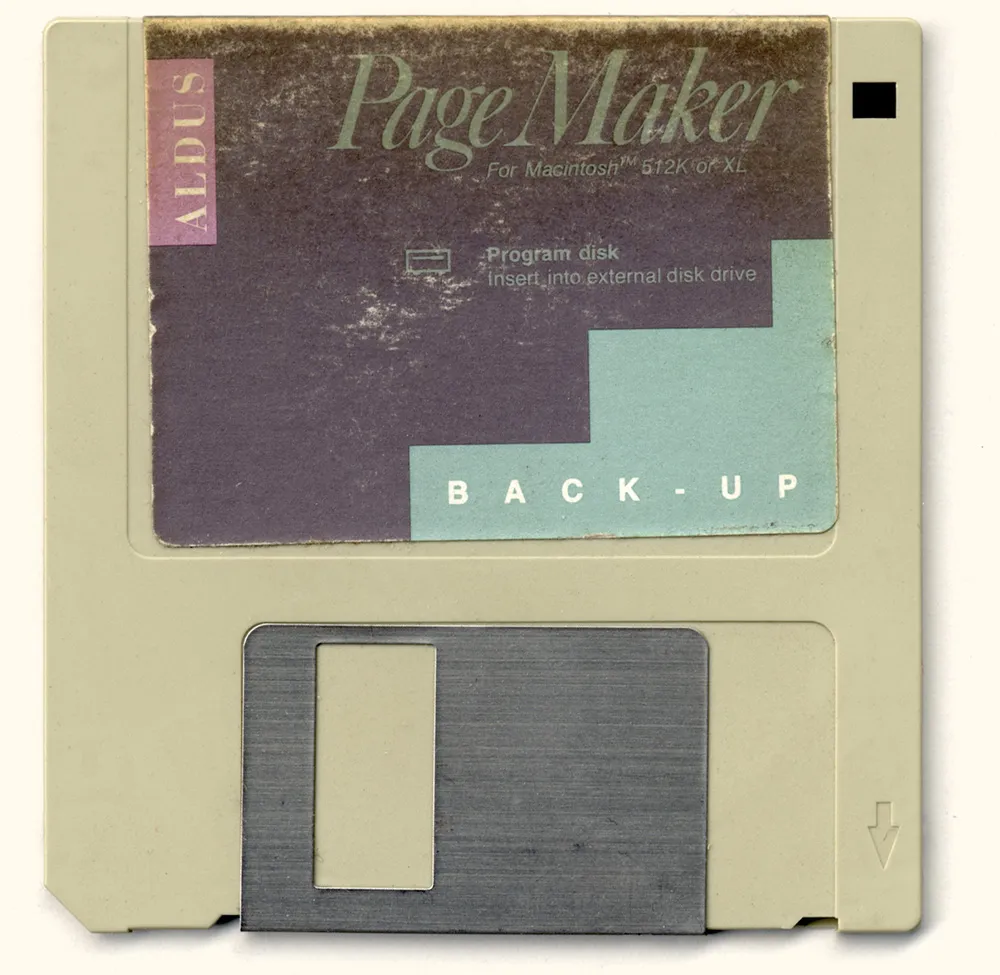
But there was a problem. There were two kinds of PostScript fonts: Type 1 and Type 3. Type 1 fonts included “hints” that improved the quality of output dramatically over Type 3 fonts. Adobe provided information on making Type 3 fonts, but kept the secrets of the superior Type 1 font technology to itself. If you wanted Type 1 fonts, Adobe was the only source. Anyone else who wanted to make or sell fonts had to settle for the inferior Type 3 format. Adobe wanted the high end of the market all to itself.
By 1989, a number of companies were hard at work trying to crack the Type 1 format or devise alternatives. Apple and Microsoft signed a cross-licensing agreement to create an alternative to Adobe’s technology. While Microsoft worked on TrueImage, a page description language, Apple developed the TrueType format. TrueType was a more open format and was compatible with—but not dependent on—PostScript. This effectively forced Adobe’s hand, causing them to release the secrets of the Type 1 format to save themselves from irrelevancy.
Around the same time, PostScript “clones” were being developed to compete with Adobe. These PostScript “work-alikes” were usually bundled with “look-alike” fonts, since the originals were owned by Adobe’s business partners. One PostScript clone, sold by Birmy, featured a Helvetica substitute developed by Monotype called Arial.
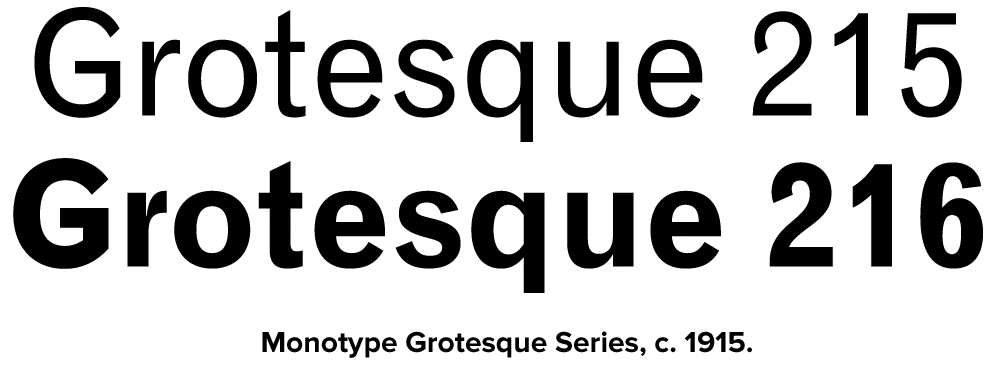
Arial appears to be a loose adaptation of Monotype’s venerable Grotesque series, redrawn to match the proportions and weight of Helvetica. At a glance, it looks like Helvetica, but up close it’s different in dozens of seemingly arbitrary ways. Because it matched Helvetica’s proportions, it was possible to automatically substitute Arial when Helvetica was specified in a document printed on a PostScript clone output device. To the untrained eye, the difference was hard to spot. (See “How to Spot Arial”) After all, most people would have trouble telling the difference between a serif and a sans serif typeface. But to an experienced designer, it was like asking for Jimmy Stewart and getting Rich Little.
What is really strange about Arial is that it appears that Monotype was uncomfortable about doing a direct copy of Helvetica. They could very easily have done that and gotten away with it. Many type manufacturers in the past have done knock-offs of Helvetica that were indistinguishable or nearly so. For better or worse, in many countries—particularly the U.S.—while typeface names can be protected legally, typeface designs themselves are difficult to protect. So, if you wanted to buy a typesetting machine and wanted the real Helvetica, you had to buy Linotype. If you opted to purchase Compugraphic, AM, or Alphatype typesetting equipment, you couldn’t get Helvetica. Instead you got Triumvirate, or Helios, or Megaron, or Newton, or whatever. Every typesetting manufacturer had its own Helvetica look-alike. It’s quite possible that most of the “Helvetica” seen in the ’70s was actually not Helvetica.
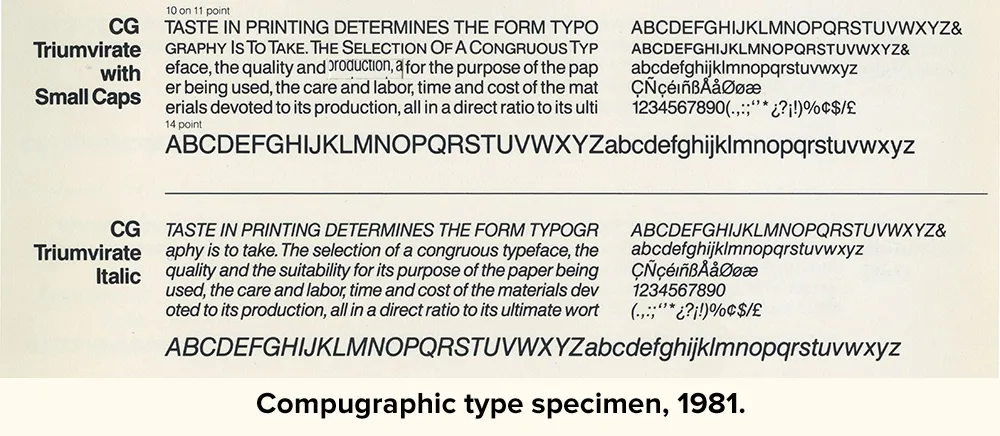
Now, Monotype was a respected type foundry with a glorious past and perhaps the idea of being associated with these “pirates” was unacceptable. So, instead, they found a loophole and devised an “original” design that just happens to share exactly the same proportions and weight as another typeface. (See “Monotype’s Other ‘Arials’”) This, to my mind, is almost worse than an outright copy. A copy, it could be said, pays homage (if not license fees) to the original by its very existence. Arial, on the other hand, pretends to be different. It says, in effect “I’m not Helvetica. I don’t even look like Helvetica!”, but gladly steps into the same shoes. In fact, it has no other role.
***
When Microsoft made TrueType the standard font format for Windows 3.1, they opted to go with Arial rather than Helvetica, probably because it was cheaper and they knew most people wouldn’t know (or even care about) the difference. Apple also standardized on TrueType at the same time, but went with Helvetica, not Arial, and paid Linotype’s license fee. Of course, Windows 3.1 was a big hit. Thus, Arial is now everywhere, a side effect of Windows’ success, born out of the desire to avoid paying license fees.
The situation today is that Arial has displaced Helvetica as the standard font in practically everything done by nonprofessionals in print, on television, and on the Web, where it’s become a standard font, mostly because of Microsoft bundling it with everything—even for Macs, which already come with Helvetica. This is not such a big deal since at the low resolution of a computer screen, it might as well be Helvetica. In any case, for fonts on the Web, Arial is one of the few choices available.
Despite its pervasiveness, a professional designer would rarely—at least for the moment—specify Arial. To professional designers, Arial is looked down on as a not-very-faithful imitation of a typeface that is no longer fashionable. It has what you might call a “low-end stigma.” The few cases that I have heard of where a designer has intentionally used Arial were because the client insisted on it. Why? The client wanted to be able to produce materials in-house that matched their corporate look and they already had Arial, because it’s included with Windows. True to its heritage, Arial gets chosen because it’s cheap, not because it’s a great typeface.
It’s been a very long time since I was actually a fan of Helvetica, but the fact is Helvetica became popular on its own merits. Arial owes its very existence to that success but is little more than a parasite—and it looks like it’s the kind that eventually destroys the host. I can almost hear young designers now saying, “Helvetica? That’s that font that looks kinda like Arial, right?”
See also:
I arrived in San Francisco late yesterday, just in time to register and catch the first presentations.
First off was Linotype’s presentation of the winners of its annual type design competition. Its pace was a bit too leisurely—good for the recipients, giving them plenty of time to talk about their work, but a little hard on the audience. The highlight was Tony and Caio de Marco’s acceptance for the third place award in the display font category, which shook the audience out of its stupor, thanks to Tony’s energetic presence.
Next up, Erik Spiekermann presented “Sex, Type & Rock & Roll,” an overview of the fonts he’s designed over the last 25 years, putting them into historical context, along with lots of witty and insightful observations about type in general. His presentation featured several bits of music, including the title song recorded by his son and a ditty accompanying a visual count-off of the 229 years that will pass before we get another year like 1999 (which has three descenders when set in old style figures).
Last up was the Typophile Film Festival, presented by Joe Pemberton and Jared Benson. By this time, it was nearly midnight, and a lot of people (especially those from the East coast) had faded out of the auditorium to head off to bed. Those who stayed enjoyed a series of short films related in one way or another to type. Some were animated type, others were films about type, and some, like the new Flash film by Cheshire Dave (of Behind the Typeface fame) are a little harder to categorize. My favorite was Helvetica Hurts (not sure about the title), a hypnotic silent symphony of dancing Helvetica characters. Not to diminish the creativity it undoubtedly took to create it, but it would make a great iTunes visualizer module.
Out in the lobby, people were chatting via video link with FontLab’s Adam Twardoch in Berlin, who was unable to attend because the US government would not give him (or Yuri Yarmola, FontLab’s lead developer) a visa. I don’t know what is wrong with people sometimes. I was looking forward to meeting Adam and seeing Yuri again. Turns out this was not the case exactly, but I still would have liked to have seen them.
I’m having too much fun actually doing the conference, so writing about it will have to wait. Sorry.
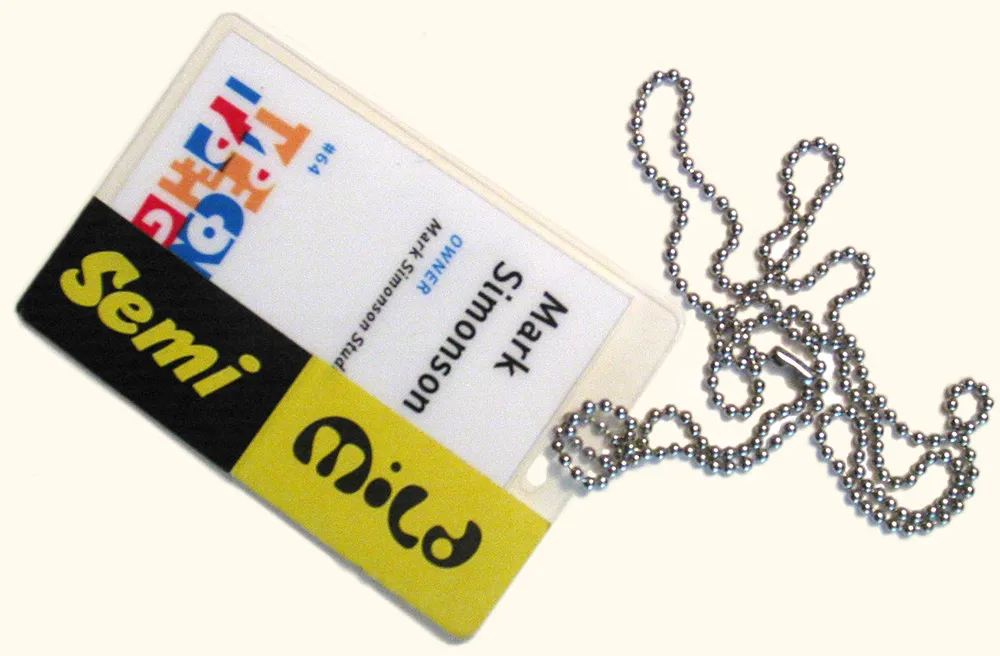
The tag shown above is what I wore around my neck the last four days at TypeCon2004. The black and yellow stickers were provided by FontShop—sort of Magnetic Poetry™ meets FontShop logo. Of course everyone had to try to out-do each other sticking funny or bizarre combinations on themselves, turning the whole conference into an ad for FontShop. Very clever.
Rather than try to continue the blow-by-blow commentary I started the other day, I’ll just share a few random thoughts:
In Roger Black’s talk on custom typefaces for magazines and newspapers Friday morning, I wished that he was speaking to a room full of publication art directors instead of type industry insiders.
Armin Vit proved that people say the darnedest things about type.
Richard Lipton’s Bickham Script and House Industry’s Ed Interlock made me even more excited than I already was about the possibilities of OpenType.
I’ve never flown on Sun Country Airlines before, and I’m not sure I want to do it again. They’re cheap and efficient, but it’s the first time I’ve thought seriously about upgrading to first class. Both ways. Enough said.
As I left one of the sessions, I had to laugh at myself as I wondered if there was a Starbuck’s nearby. Just like the comic cliché, I found one almost immediately by picking a direction at random.
It never occurred to me that the Black Panther Party used Letraset and cheap Compugraphic typesetting machines. Duh. That’s what everyone without a budget (including me) used to use.
Ken Barber and Ed Benguiat make a great comedy team, but Ed could easily take his act solo. Seriously, the tribute to Ed was the highlight of the event for me. I can’t describe how great it felt to be part of the crowd giving Ed not one but two standing ovations before it was over.
Christian Schwartz is not only a very talented young type designer, he can also do a pitch-perfect impression of Erik Spiekermann.
The Underware guys are freakishly talented at drawing letters and know how to put on a good show. Their presentation about TypeRadio started with a brilliant animated movie they made at the conference—apparently in their room on hotel stationery—that very neatly set the tone for the rest of their presentation. I’d love to get hold of a copy of it.
Akira Kobayashi made a surprise announcement that there is a Palatino Sans in our future (along with a completely new and improved Palatino). Even more surpising is that it looks pretty nice.
The Font Bureau’s Dyana Weissman knocked everyone off the dance floor at the party on Saturday night. In some cases, literally, so I heard. I missed a lot of this because I and five or six others learned how to get up to the roof away from the noise of the party. It was very pleasant up there. I had a nice conversation with Frank Jonen about, among other things, what it’s like to work with Herman Zapf. We must have been up there for quite a while because a lot of people were gone by the time we came back down.
The party also featured a type trivia quiz. I tied for third with Stephen Coles and somebody else with 36 out of 50 possible points. Stephen won the tie breaker with the correct answer of Nick Shinn as the designer of Fontesque. (I knew it too, but Stephen buzzed in first.) Not surprisingly, Jon Coltz won (over 40 correct, I think.)
In what is becoming a TypeCon tradition, John Downer removed and sold the shirt off his back.
The conference sessions ended on a poignant note with Dan X. Solo’s moving eulogy to metal type—pegging the American Type Founders auction in 1993 as the day Gutenburg really truly died.
After that, a lot of people said their goodbyes. Many left or got on one of the buses up to Sumner Stone’s farm for a picnic. A few of us stayed behind at the hotel for various reasons (I had to catch a plane home before the bus would be back). I ended up spending a pleasant afternoon and dinner with Ray Cruz and Gary Munch. (I’ll be curious to hear how the picnic went.)
I barely slept on the flight home to St. Paul and got in early morning. I saw my family off for the day, posted a new “sponsor” letter on Notebook, and crashed on the couch.
Can’t wait until next year.
I meant to take more photos than this at the conference, but here are a few. Sorry, no drunken typophiles or attention to white balance.
